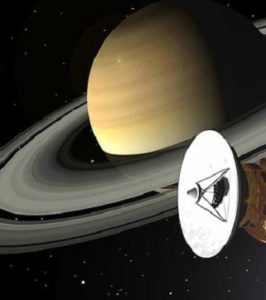
New data received from NASA’s Cassini probe suggests that Saturn’s icy moon Enceladus may have tilted or tipped over in the past after a collision with some other celestial body such as an asteroid.
In the past, NASA had said that Enceladus had all the basic ingredients to support life. It has a warm subterranean ocean beneath its crust, and it produces enough energy from its hydrothermal vents to support alien microbes.
Now NASA researchers say they have found new evidence which reveals that Enceladus’ spin axis has reoriented, and that the moon tipped away from its original axis by about 55 degrees. Enceladus’ spin axis is the line through the north and south poles of this moon. A smash-up was earlier used to explain Enceladus’ unusual “tiger stripes”, geysers of water erupting at south pole of this moon.
“We found a chain of low areas, or basins, that trace a belt across the moon’s surface that we believe are the fossil remnants of an earlier, previous equator and poles,” said Radwan Tajeddine, a Cassini imaging team associate at Cornell University in the US.
“The geological activity in this [tiger stripe] terrain is unlikely to have been initiated by internal processes,” the study’s lead author, Radwan Tajeddine, a Cassini imaging team associate at Cornell University, said in a statement. “We think that, in order to drive such a large reorientation of the moon, it’s possible that an impact was behind the formation of this anomalous terrain.”
Scientists think asteroid may have collided with the region in the past when it was close to the equator.
Scientists also believe that it would have taken Enceladus over a million years to get its crap together and stabilise — in the meantime, its north and south poles would have shifted greatly in a phenomenon called “true polar wander”.
Cassini was launched in 1997, and since reaching Saturn in 2004, it has been completing circles around the Saturn. For the past 13 years, it has collected and sent huge amount of data to help scientists have a better understanding of Saturn and its moons.
